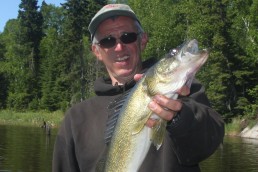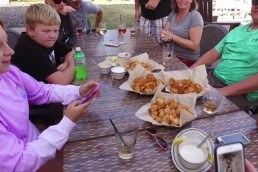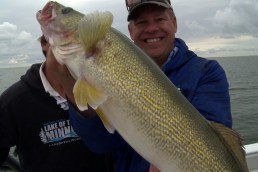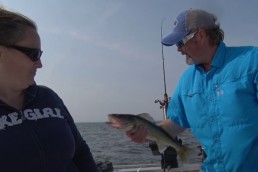Campground Walleyes and Tips from the Pros
SHARE THIS POST
Walleye fishing in Michigan is very good, and getting even better. Lakes like Houghton, Burt, Mullet, Muskegon and Hamlin Lake offer great walleye fishing and are premier vacation destinations to hit. Taking the information from past trips and that of guides and fellow anglers, these should offer you a great time.
“Mullet Lake is one of my all-time favorite lakes”, said Chad Schut, of Walleyechad Charters, LLC.
Schut is a diverse angler but he loves his trolling. On Mullet, he suggested concentrating in depths between 15 and 20 feet. He says to look for rock piles, humps and sunken islands.
“My trolling motor is always in the water and the primary source of power,” Schut said.
He also likes using his side scan or down scan, depending on the depth. Locating fish and baitfish is critical to him and says to try working the area that is receiving the most wind.
On Mullet, he finds that crankbaits do great, especially Shad Raps, Flickers and Deep Little Rippers and Reef Runners. Color is not as important to Chad as is the right location and the best action.
He recommends playing around with different models and different lures until the fish show a preference.
“Ten-pound-test mono is used with the planner boards,” Schut says. “Mono provides more of a shock absorber than braid.” He adds that long leads at 90-110 feet work on Mullet and running two or three boards on each side creates a nice spread.
Next door to Mullet is Burt Lake, and this water has a standing reputation of producing.
Ken Clark of Fishmas Charters loves this lake and spends a lot of time there with success.
“The ‘crawlers are my bread-and-butter bait on Burt Lake until fall, when I switch over to jigging raps.”
Clark added that trolling a ‘crawler harness throws off vibration and scent and that a fat, healthy ‘crawler is key. He then says to fill a cooler full of ice then add water halfway up and then add your ‘crawlers. These will plump up nicely and the boat stays clean.
Ken likes to troll in the top 15 feet of the water column and searches out humps, baitfish and ambush spots. His best fishing takes place in the later part of the summer, but in May many use ‘crawler-harness rigs while drifting or slow trolling on the bottom or near the weed beds.
On Muskegon Lake, Capt. Dan Hassevort targets weed beds in 8 to 14 feet of water. One prime location is near the state park boat launch. This is a great location at the opener and through May, then once again in the fall after Labor Day. Another prime location early in the season is on the east end where the various branches of the Muskegon River dump into Muskegon Lake.
Good bait choices include spinner rigs and crankbaits. Capt. Hassevort runs a lot of the Mag Lips, and in spring he said you could start with the 2.5 and in the fall bump up to the 3.0 or the 3.5 series.
He adds that in summer you should try the breaklines near the larger weed flats, humps, and tight contour breaks bordering the old riverbed. He says the wood slab files are found in earnest on the south shoreline and the north shoreline.
Are you enjoying this post?
You can be among the first to get the latest info on where to go, what to use and how to use it!
Hamlin Lake is one of my all-time favorite vacation destinations. There is a lot to like, starting with the diverse fishing opportunities with crappies, bluegills, bass and walleyes.
There are two great ways to fish the walleyes.
“Jigging weeds or trolling over the tops of new weed growth is very productive,” said Bryan Buist, of 2 B Caught Charters. “Early in the season, many anglers hit the new cabbage weed growth, and points and bars are also great locations.”
Some of the largest cabbage flats are near the dunes area. You can’t miss the dunes on the west end of the lake.
Around the Fourth of July, my son and I find success in 60- to 80-foot depths along the old river channel. Our favorite method is drifting or slow-trolling bottom bouncers and often requires weights at 2 to 4 ounces.
At these depths, we mix things up trying both a ‘crawler spinner and a death hook rig with a Smyle Blade. We like glow-in-the-dark colors or something giving off tons of flash like brass blades. We’ll also paint my bottom bouncers. Power-painting a bouncer with a white base and following up with the glow colors is ideal.
Houghton Lake is another regular destination spot for anglers, with plenty of cover.
“Walleye anglers land tons of nice fish on the weeds,” says Kurt Beachnau, owner of Lyman’s on Houghton Lake. “Some troll the original floating small Rapalas with split shot while others use either a leech or a ‘crawler on a harness rigs.”
Another great technique again is the slip float. Some anglers use a red hook; others use a gold hook. Many prefer a jig head tipped with the leech. The jig head adds color and eliminates the need for a sinker.
“An overlooked lure is the Beetle Spin,” Beachnau said, and adds the leech to the spinner.
Another favorite lure for ‘gills or walleyes is the Northland Tackle’s Whistler Jig. This small propeller jig head slices through the weeds and throws off flash and vibration.
Trolling through cover is once again preferred here.
“Walleyes concentrate on ‘good’ green cabbage, and 90 percent of the time they will be there,” says Lance Valentine, who guides on inland lakes, the Detroit River and Lake Erie.
He says drifting over and through with a bullet sinker and a death-hook rig or a spinner rig is a favorite on a weedy lake. A 3/16- to 3/8-ounce bullet sinker with a rattle bead and a Mack Smyle blade on a 10-pound-test leader on a death hook, or a floating jig head, works great in, over and on the edges of weeds he says.
A popular plastic bait that many guides and pros use is the S Minnow or the Fin S Fish plastics from Lunker City. These are part of a drop-shot system designed for anglers regardless of their skill set. Your hook should be tied to the main line with a Palomar knot, and you want the hook upward. You’ll also want to leave a 24-inch tag line below your hook or lure. This is the part of the system that allows you to quickly adjust the length of the dropper from the sinker to your bait. The fish that are tight to the bottom require a shorter lead, while fish riding high require a longer lead. Having your hook or bait tied directly to your main line does a number of things, including allowing you to feel the slightest of hits, present any type of bait in a natural fashion and help you have your bait in the right zone.
Each of these lakes above has campgrounds on them, and most are state parks. All of them have cabins and resorts and all have other activities besides fishing. These basic techniques are can be easily mastered at these locations and will put plenty of walleyes into your boat.
MWO
SHARE THIS POST
Did you enjoy this post?
You can be among the first to get the latest info on where to go, what to use and how to use it!
Jack Payne
Jack Payne is an accomplished angler and hunter who enjoys teaching others as much as learning from others. Seminar speaker, outdoor photography enthusiast, hunter safety instructor and volunteer at many events for both kids and adults as an instructor.



